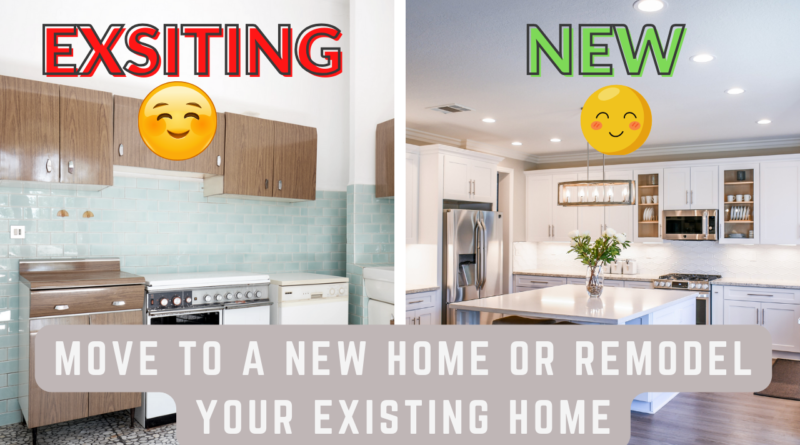How to Decide if It Makes Financial Sense to Move to a New Home or Remodel Your Existing Home
Deciding whether to move to a new home or remodel your existing home is a financial and emotional decision that needs careful thought. Both options have their good and bad points. To make the best choice, you need to look closely at your finances, personal needs, and the housing market. This article will help you in making the right choice for your situation.
Step 1: Determine What Remodeling Projects You Want to Done
The first step in deciding to remodel or move is to list the changes you want to make to your current home. Look around and see which areas need fixing or updating.
- Kitchen Remodeling:
- The kitchen is often considered the heart of the home, and updating it can significantly enhance your living experience. Consider upgrading appliances to energy-efficient models, replacing countertops with durable materials like granite or quartz, and updating cabinetry for better storage. Modern kitchens with open layouts and functional design are highly desirable.
- Bathroom Remodeling:
- Bathrooms are another key area that can benefit from remodeling. Think about replacing outdated fixtures with modern, water-saving options, installing new tiles, and adding features like a walk-in shower or a soaking tub. Improved lighting and ventilation can also make a big difference.
- Adding Great Rooms:
- Great rooms, which combine living, dining, and kitchen areas into one open, multifunctional space, are increasingly popular. They create a more spacious and connected living environment, ideal for family gatherings and entertaining guests.
- Luxury Bedrooms:
- Creating a luxurious master suite can add significant value to your home. Consider adding features like a walk-in closet, en-suite bathroom with high-end fixtures, and a sitting area. These upgrades can make your home more appealing to potential buyers and provide you with a comfortable retreat.
- Other Considerations:
- Don’t forget about smaller projects that can enhance your home’s appeal, such as updating flooring, painting, improving landscaping, or adding a home office. These projects can improve your daily living experience and add value to your home.
By listing out all the changes you’d like to make, you can prioritize them based on your budget and needs, ensuring that your remodeling efforts are focused on the most impactful areas.
Step 2: Get Estimates from Contractors
Once you have a clear idea of the remodeling projects you want to undertake, the next step is to get estimates from contractors. This is a crucial step in understanding the financial possibility of remodeling.
- Research and Shortlist Contractors:
- Start by researching local contractors and reading reviews to find reputable professionals. Ask for recommendations from friends, family, or neighbors who have recently completed similar projects.
- Request Detailed Estimates:
- Contact several contractors and request detailed quotes for the projects you have in mind. Make sure the estimates include:
- Material Costs: The price of all materials needed for the project, from flooring and fixtures to paint and appliances.
- Labor Costs: The cost of hiring workers to complete the project.
- Permits: Any necessary permits for construction work, which vary by location and project type.
- Unexpected Costs: A buffer for any unexpected expenses that may arise during the project, such as structural repairs or additional work discovered during the remodel.
- Contact several contractors and request detailed quotes for the projects you have in mind. Make sure the estimates include:
- Compare Estimates:
- Carefully compare the estimates from different contractors. Look for transparency in pricing and ensure that each estimate covers all aspects of the project. Don’t be tempted to choose the lowest bid without considering the quality of work and the contractor’s reputation.
- Interview Contractors:
- Interview the shortlisted contractors to gauge their expertise and communication style. Ask about their experience with similar projects, timelines, and how they handle unforeseen issues. A good contractor should be able to provide references from previous clients.
Step 3: Consult a Realtor for Your Current and Post-Remodel Home Value
Understanding the current and potential future value of your home is essential in deciding whether to remodel or move. A local realtor can provide invaluable insights into the real estate market and help you assess the financial impact of your decision.
- Assess Current Home Value:
- Ask a local realtor to perform a comparative market analysis (CMA) to determine your home’s current value. This analysis considers recent sales of similar homes in your area, current market conditions, and the unique features of your property.
- Estimate Post-Remodel Home Value:
- Provide the realtor with details of your planned remodeling projects and ask for an estimate of your home’s value after the remodel. Realtors have access to market data and trends that can help predict how your planned renovations might affect your home’s value.
- Understand Market Dynamics:
- Discuss the broader real estate market trends with your realtor. Are home values in your area increasing or decreasing? Are there any upcoming developments or changes in the neighborhood that could impact property values? Understanding these dynamics can help you make a more informed decision.
- Consider the Neighborhood:
- The value of your home is not just based on the improvements you make, but also on the overall market trends and values in your neighborhood. If your home is already the most expensive on the block, additional renovations might not yield a significant return.
By consulting a realtor, you can get a clear picture of your home’s current and potential value, helping you weigh the financial benefits of remodeling against the cost of moving.
Step 4: Calculate the Financial Impact of Remodeling
With the estimates and home values in hand, you can now calculate the financial impact of the remodel. This involves subtracting the estimated remodeling costs from the projected post-remodel home value to determine the potential equity gain.
- Calculate Equity Gain:
- Use the following formula to calculate the equity gain from remodeling:
- Equity Gain = Post-Remodel Home Value – (Current Home Value + Remodeling Costs)
- Use the following formula to calculate the equity gain from remodeling:
- Example Calculation:
- Current Home Value: $300,000
- Estimated Remodeling Costs: $50,000
- Estimated Post-Remodel Home Value: $380,000
- Equity Gain: $380,000 – ($300,000 + $50,000) = $30,000
- Interpret the Results:
- If the post-remodel home value minus the remodeling costs is greater than your current home value, remodeling could be a good investment. In this example, the remodel increases the home’s value by $30,000, making it a potentially worthwhile investment.
- Consider Financing Options:
- If you need to finance the remodel, consider the terms of a home improvement loan or a home equity line of credit (HELOC). Factor in the interest rates and repayment terms when calculating the overall cost of remodeling.
By accurately calculating the financial impact of remodeling, you can determine whether the investment is likely to pay off and how it compares to the potential cost of moving.

Step 5: Compare Monthly Payments: Existing vs. New Home
Next, you need to compare your existing monthly mortgage payment with the potential monthly payment on a new home. This comparison should include any additional payments you might have, such as a home improvement loan for the remodel.
- Calculate Current Monthly Costs:
- Add up your current mortgage payment and any home improvement loan payments. This gives you the total monthly cost of staying in your remodeled home.
- Estimate New Home Monthly Costs:
- Based on the price of homes you’re considering, calculate the potential monthly mortgage payment using current interest rates and loan terms. Use online mortgage calculators or consult with a mortgage lender to get accurate estimates.
- Example Calculation:
- Current Monthly Mortgage Payment: $1,500
- Home Improvement Loan Payment: $200
- Total Current Monthly Payment: $1,700
- Potential New Home Price: $400,000
- Estimated New Mortgage Payment: $2,000
- Evaluate Monthly Payment Differences:
- Determine whether you would pay more monthly for your remodeled home or a new home. This will help you assess the long-term affordability of both options.
In this example:
- Total Current Monthly Payment (Remodeled Home): $1,700
- Estimated New Mortgage Payment (New Home): $2,000
The monthly payment for the new home is $300 higher than the remodeled home. Consider whether the additional cost fits within your budget and aligns with your financial goals.
Step 6: Evaluate Monthly Payment Differences
To determine which option is more affordable in the long run, compare the monthly payments and evaluate the financial impact on your budget.
- Analyze Affordability:
- Consider your current income and expenses to see if you can comfortably afford the new home’s higher mortgage payment. Ensure that the new payment doesn’t strain your budget or affect your ability to save for other financial goals.
- Factor in Additional Costs:
- Moving to a new home often involves additional costs such as property taxes, homeowners’ insurance, and maintenance expenses. Make sure to include these in your calculations.
- Consider Long-Term Financial Goals:
- Think about your long-term financial goals, such as saving for retirement, college funds, or other investments. Ensure that your decision supports these goals and doesn’t compromise your financial stability.
- Personal Financial Health:
- Assess your overall financial health, including your savings, debt levels, and credit score. A healthy financial position can give you more flexibility in choosing between remodeling and moving.
By evaluating the monthly payment differences and considering your overall financial health, you can make a more informed decision that aligns with your long-term financial goals.
Step 7: Make a Decision Based on Investment and Monthly Payments
After thoroughly analyzing the financial aspects of both options, it’s time to make a decision. Consider the following factors to ensure you make the best choice:
- Investment Potential:
- If remodeling your home provides a good return on investment and keeps your monthly payments manageable, it may be the best choice. Look at the potential equity gain and the impact on your home’s value.
- Affordability:
- Ensure that the option you choose is affordable and doesn’t overextend your budget. Consider both the immediate and long-term financial impact on your monthly payments and overall financial health.
- Personal Factors:
- Financial considerations are important, but personal factors also play a crucial role. Think about your attachment to your current neighborhood, the convenience of your commute, the quality of local schools, and the impact on your children. These factors can greatly influence your decision.
- Market Conditions:
- Pay attention to the real estate market. If it’s a buyer’s market, you might find great deals on new homes. Conversely, if it’s a seller’s market, remodeling might be more advantageous.
By carefully considering these factors and weighing the financial and personal aspects of both options, you can make a well-informed decision that best suits your needs and circumstances.
ALSO READ : 5 Best Free Budgeting Apps For 2024
Tips for Maximizing Value
- Focus on High-Value Areas:
- Remodeling kitchens and bathrooms typically adds the most value to your home. These areas are important to buyers and can significantly increase your home’s market appeal. Focus on high-quality materials and modern designs to maximize the impact.
- Consider Current Trends:
- Great rooms and luxury bedrooms are popular among buyers. Creating open, multifunctional spaces or luxurious master suites can make your home more attractive. Stay updated on current design trends and incorporate features that appeal to today’s buyers.
- Remember Hidden Moving Costs:
- If you decide to move, remember to factor in additional costs such as realtor commissions, closing costs, and moving expenses. These can add up quickly and impact your overall budget. Make sure to budget for these expenses to avoid any surprises.
- Personal Factors Matter:
- Financial considerations are important, but personal factors also play a crucial role. Think about your attachment to your current neighborhood, the convenience of your commute, the quality of local schools, and the impact on your children. These factors can greatly influence your decision.
Warnings
- Consult a Realtor Before Remodeling:
- Always seek professional advice from a realtor before starting any remodeling project. The value of your home is highly influenced by the value of surrounding homes, and a realtor can provide insight into whether your planned renovations will be a good investment.
- Consider the Neighborhood:
- The value of your home is not just based on the improvements you make, but also on the overall market trends and values in your neighborhood. If your home is already the most expensive on the block, additional renovations might not yield a significant return.
- Be Realistic About Costs:
- Home improvement projects often come with unexpected expenses. Make sure to budget for contingencies and don’t stretch your finances too thin. It’s better to have a financial cushion than to face unexpected financial stress during the remodeling process.
Making Your Final Decision to Move to a New Home or Remodel Your Existing Home
Ultimately, the decisionto Move to a New Home or Remodel Your Existing Home comes down to balancing financial factors with personal considerations. Here are some final points to help guide your decision:
- Financial Stability:
- Ensure that whichever option you choose, it aligns with your financial goals and doesn’t overextend your budget. A financially stable decision will provide peace of mind and long-term benefits.
- Long-Term Plans:
- Consider how long you plan to stay in your current home. If you’re planning to move in a few years, investing heavily in remodeling might not be worthwhile. On the other hand, if you plan to stay for the long term, remodeling can enhance your living experience and add value to your home.
- Lifestyle Needs:
- Think about your family’s lifestyle and needs. If your current home can be remodeled to better suit your needs, it might be more convenient than moving. Consider the impact on your daily life, including the convenience of your commute, proximity to schools, and overall quality of life.
- Market Conditions:
- Pay attention to the real estate market. If it’s a buyer’s market, you might find great deals on new homes. Conversely, if it’s a seller’s market, remodeling might be more advantageous. Understanding market conditions can help you make a strategic decision.
By carefully evaluating these factors and following the steps outlined in this article, you can make a well-informed decision on whether to Move to a New Home or Remodel Your Existing Home. Balancing financial considerations with personal factors will help ensure that you make the best choice for your situation. Whether you choose to remodel your existing home or move to a new home, the key is to ensure that the decision supports your overall goals and improves your quality of life.




